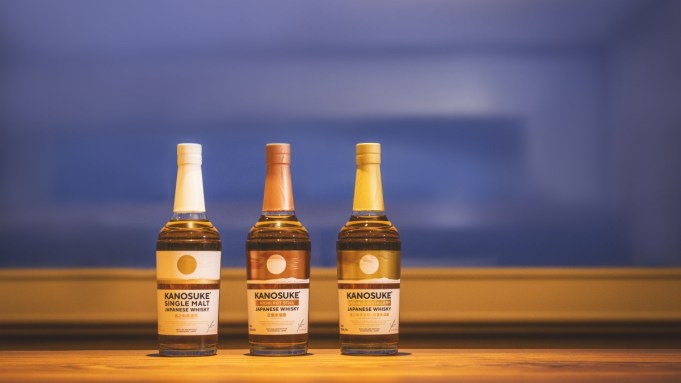Japanese whisky is getting interesting again. To be clear, it’s not like the category is boring, but the fantastic age statement single malts from brands like Suntory and Nikka remain extremely expensive and limited in quantity making it hard for people to actually taste, which in turn has opened the door to a new wave of distilleries and brands. One of the most interesting to enter the U.S. market is Kanosuke, which just launched a trio of new whiskies—and the standout is an unusual pot still grain whisky inspired by Ireland’s signature uisce beatha.
There’s a good chance you haven’t heard of Kanosuke before—the distillery has been around since 2017, but has not had much whisky available in the U.S. until now. Kanosuke got a financial boost when Diageo invested in the distillery back in 2021 through its Distill Ventures incubator, although with the recent news about the drinks corporation’s profits falling that could change in the future. It’s headed up by Yoshitsugu Komasa, the fourth-generation member of a family that has been making shochu for more than 140 years. Shochu, a low-ABV spirit usually made from potatoes, rice, or barley, is of course very different from whisky, although the distillery does bring some of those techniques to its production model.
At Kanosuke, Komasa and his team are adhering to the still voluntary regulations that were set up a few years ago to more strictly define Japanese whisky—crucially, having the term mean it was produced in Japan as opposed to being imported from Scotland or other countries and blended. There are three Kanosuke expressions available that are made using mostly imported malted barley along with a small percentage that is grown in Japan: a single malt, a blend, and the pot still grain whisky that is the subject of this review.
Kanosuke Pot Still Grain Whisky is actually distilled at a sister distillery called Hioki, which is primarily used to make shochu. The reason why this is a grain whisky, and not a single malt, is that it’s made from a mashbill of malted and unmalted barley, which brings us to the Irish whiskey comparison. Irish pot still whiskey is also made from a mashbill of malted and unmalted barley and distilled in a pot still, which gives it a very distinct fruity flavor with a viscous mouthfeel, both traits that carry over to this Japanese whisky. And the similarities don’t end there. After being distilled in pot stills at Hioki, the whisky is aged in new American oak puncheons and ex-bourbon barrels for a minimum of three years. There is a creamy caramel coating to the palate, along with notes of stewed apple, orange zest, vanilla, milk chocolate, and a mixture of black pepper and cinnamon on the palate.
Overall, this new release is truly unlike any other Japanese whisky you’ve likely tried, and completely different from the single malts and blends that dominate the category. If you’re looking for something to try in the category beyond Yamazaki, Hibiki, or Yoichi, and you’re a fan of Irish single pot still whiskey like Redbreast, give this new bottle from Kanosuke a try.
Score: 89
- 100 Worth trading your first born for
- 95 – 99 In the Pantheon: A trophy for the cabinet
- 90 – 94 Great: An excited nod from friends when you pour them a dram
- 85 – 89 Very Good: Delicious enough to buy, but not quite special enough to chase on the secondary market
- 80 – 84 Good: More of your everyday drinker, solid and reliable
- Below 80 It’s alright: Honestly, we probably won’t waste your time and ours with this
Every week Jonah Flicker tastes the most buzzworthy and interesting whiskeys in the world. Check back each Friday for his latest review.


